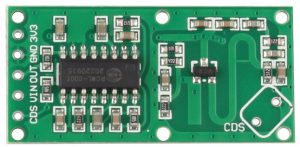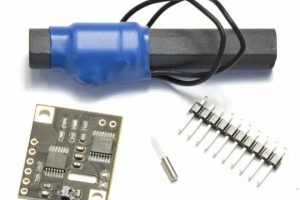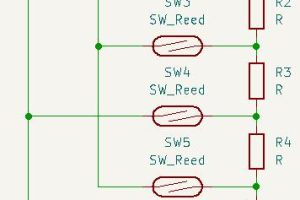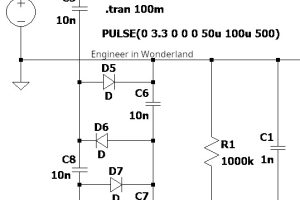
There is a bunch of different models, all doing roughly the same thing in the same way: detecting moving people and other conductive objects up to a few metres away – RCWL-0516 is an example.
In behaviour, they are much like PIR detectors, but with radar rather than infra-red.
In each case, all of the RF work is done with a single transistor – oscillator, transmitter, receiver and detector – and then a simple analogue IC decides whether the detected signal should cause the output to switch or not.
The transmitted signal is somewhere around 3GHz, and the modules rely on detecting the Doppler shift of returns from moving objects.
Power is needed at ~5V or above, and they have a 3.3Vpower output as well as a 3.3V logic output.
Consumption is a few mW, and that seems a bit much for emitting a random frequency, so maybe check they are legal where you are is you want to try one – or keep all the RF indoors.
All very neat.
Hats off to Andreas Spiess and his excellent YouTube channel for bringing these bargain radars to my attention – he also has a video on more modern, higher frequency, radar modules.
The image was taken, nearly randomly, from Haljia’s Amazon UK advert here – gratitude is being shown here, not buying advice. If the image has been used incorrectly, please get in touch so that it can be removed immediately.
 Electronics Weekly Electronics Design & Components Tech News
Electronics Weekly Electronics Design & Components Tech News




The 1940s version:
https://maritime.org/doc/vtfuze/index.php
There’s even a circuit diagram or two & explanations of how it works.
Radar based people detector modules using Gunn Diodes predate PIR sensors. I recall looking at PIR controlled lights in the early 1990s and calculated the payback time would be about 15 years compared to a much cheaper Dusk till Dawn light.
A couple of years ago, after the disappointingly quick failure of a PIR light on an exposed wall I bought a wall light with a Radar Controlled switch on the basis that everything is sealed entirely inside the light. The only problem with it is that it is a fairly effective weather radar and in stormy weather it will spend more time on than off. It works well for about 350 days a year though.
Thanks Duncan
Didn’t know that about radar pre-dating PIR !
The IEEE were writing about radar people detectors in 1971.
https://ieeexplore.ieee.org/document/1122952
A decade later it was common to see them in places like shops.
Probably the same era as half sphere cameras with five lenses that would swing around 90 degrees every so often. I wonder how many TV cameras (if any) they had behind the lenses ?
I remember some of my Esteemed Customers (students) finding little radar modules but I don’t think those were they.
As is the wont of Esteemed Customers they blew them up left right & centre.
Well you’ve got to learn, haven’t you?
Morning zeitghost
Did any of them work out how the boards worked before they destroyed them?
My first full-time job was among folk who could tell their microstrip from their stripline, but sadly none of it rubbed off on me. I get it that the wiggly line is an antenna, and maybe an inductor, but what are the circles on the back, and all the other clever pcb tracks, for????
Do you have a photo of the back ? I suspect they are to provide directionality to the antenna.
Afternoon Mike
Big Clive took a look at one a few years ago, and you can see both sides clearly
https://www.youtube.com/watch?v=Hf19hc9PtcE
Any ideas?
Yes. It looks like the same as reflector on the back end of a television aerial. Doubt if it’s that efficient unless standard FR4 just happens to have the correct spacing though 🙂
Thanks Mike
Aerials are such interesting things – but more magic that science for me 🙂
Goodness me, no, our Esteemed Customers could barely cope with LF much less that sort of thing.
Once I did a demo of cutting a 433MHz quarter wave antenna for max sensitivity & it was treated as some sort of magic.
Adjusting for max power with a pair of wire cutters.
As a magician how we think of you at Electronics Weekly Towers. I would have been one of the wide-eyed audience 🙂
The nearest I ever got to microwaves was being allowed to apply a torque spanner to SMA connectors on the end of rigid coax (but only with a grown-up looking-on..)
I do remember using a scope to look into the signal chain of an 27MHz receiver, and being amazed at the enormous second-by-second variation in amplitude due to the transmitter being hand-held – no wonder RF folk use log scales. Equally amazing was that the AGC was easily coped with it, despite it being a cheap few-transistor hobby radio control unit.
About 5 or 6 years ago, I built a radio control transmitter out a 1966 Practical Electronics which worked quite well.
The super regen receiver that went with it was a dead loss, I ended up using a Ferranti ic instead, which, apart from being almost pure unobtainium, worked rather well.
I still can’t understand how the super regen was supposed to work.
Then again the devices specified in the original article were also unobtainium so maybe that was part of the problem.